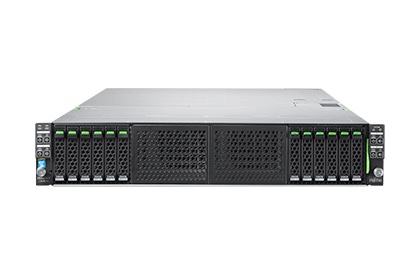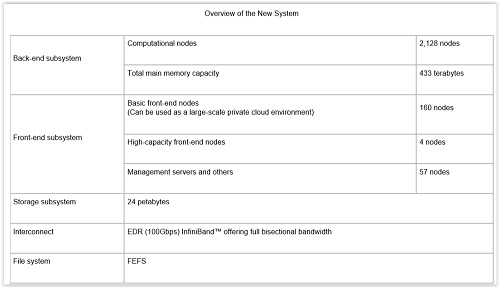 Today Fujitsu announced an order from the Research Institute for Information Technology at Kyushu University for a new supercomputer system for deployment in October 2017.
Today Fujitsu announced an order from the Research Institute for Information Technology at Kyushu University for a new supercomputer system for deployment in October 2017.
This system will consist of over 2,000 servers, including the Fujitsu Server PRIMERGY CX400, the next-generation model of Fujitsu’s x86 server. It is expected to offer top-class performance in Japan, providing a theoretical peak performance of about 10 petaflops. This will also be Japan’s first supercomputer system featuring a large-scale private cloud environment constructed on a front-end sub system, linked with a computational server of a back-end sub system through a high-speed file system.
The Research Institute for Information Technology will use this system as computational resources for JHPCN and HPCI, as well as a variety of user programs. By making this system available to users both inside and outside of the university, it will enhance the platform for academic research in Japan and contribute to the development of new academic research including AI. Fujitsu will use the technology and experience it has developed as Japan’s top supercomputer maker to strongly support the activities of the Research Institute for Information Technology.
As a center for education and research, Kyushu University is the largest public university in the Kyushu region, and the Research Institute for Information Technology is a nationwide joint-use facility visited by professors, graduate students, and researchers across Japan for academic research.
 Currently, the Research Institute for Information Technology operates three systems: a supercomputer system (consisting of the Fujitsu Supercomputer PRIMEHPC FX10 system), a high-performance computational server system (made up of Fujitsu PRIMERGY CX400 x86 servers), and a high-performance applications server system. The three systems will be integrated as part of the new supercomputer system, creating an environment that can meet an even wider variety of needs, extending beyond the current large-scale computation and scientific simulations, to include usage and research that require extremely large-scale computation, such as AI, big data, and data science.
Currently, the Research Institute for Information Technology operates three systems: a supercomputer system (consisting of the Fujitsu Supercomputer PRIMEHPC FX10 system), a high-performance computational server system (made up of Fujitsu PRIMERGY CX400 x86 servers), and a high-performance applications server system. The three systems will be integrated as part of the new supercomputer system, creating an environment that can meet an even wider variety of needs, extending beyond the current large-scale computation and scientific simulations, to include usage and research that require extremely large-scale computation, such as AI, big data, and data science.

System Features
- Server System. The server system of the new supercomputer system will consist primarily of a back-end subsystem, a front-end subsystem, and a storage subsystem.
- Back-end subsystem. The computational nodes will be made up of 2,128 PRIMERGY CX400 systems, the next-generation model of Fujitsu’s x86 server, equipped with Intel Xeon processor Scalable family (codename: Skylake). 128 of these servers will be equipped with four NVIDIA Tesla P100 GPU computing cards each (a total of 512 cards/ NVIDIA NVLink (4) used to connect GPUs).
- Front-end subsystem. This system will consist of 160 basic front-end nodes featuring Intel Xeon processor Scalable family (codename: Skylake) and NVIDIA Quadro P4000 graphics cards, as well as four high-capacity front-end nodes featuring 12 terabytes of memory each, and other servers.
- Storage subsystem. Fujitsu will deploy a disk array system with an effective capacity of over 24 petabytes.
- Interconnect. Using the latest high-speed interconnect EDR InfiniBand to connect between the servers, this system offers high parallel computation performance and availability.
- File System. This supercomputer system will be built using FEFS, Fujitsu’s high capacity, high performance, high reliability distributed file system with a proven track record both inside and outside Japan.
- Power Saving Feature. This will incorporate a system to monitor electricity usage. By using the Fujitsu Software Technical Computing Suite, the HPC middleware, this system will flexibly control electricity usage through such functions to limit the maximum electricity consumption for each system user.




